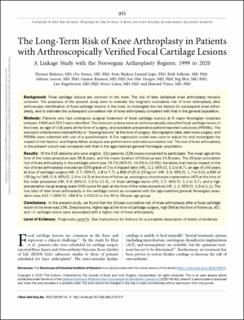| dc.description.abstract | Background: Focal cartilage lesions are common in the knee. The risk of later ipsilateral knee arthroplasty remains unknown. The purposes of the present study were to evaluate the long-term cumulative risk of knee arthroplasty after arthroscopic identification of focal cartilage lesions in the knee, to investigate the risk factors for subsequent knee arthroplasty, and to estimate the subsequent cumulative risk of knee arthroplasty compared with that in the general population.
Methods: Patients who had undergone surgical treatment of focal cartilage lesions at 6 major Norwegian hospitals between 1999 and 2012 were identified. The inclusion criteria were an arthroscopically classified focal cartilage lesion in the knee, an age of ≥18 years at the time of surgery, and available preoperative patient-reported outcomes (PROMs). The exclusion criteria were osteoarthritis or “kissing lesions” at the time of surgery. Demographic data, later knee surgery, and PROMs were collected with use of a questionnaire. A Cox regression model was used to adjust for and investigate the impact of risk factors, and Kaplan-Meier analysis was performed to estimate cumulative risk. The risk of knee arthroplasty in the present cohort was compared with that in the age-matched general Norwegian population.
Results: Of the 516 patients who were eligible, 322 patients (328 knees) consented to participate. The mean age at the time of the index procedure was 36.8 years, and the mean duration of follow-up was 19.8 years. The 20-year cumulative risk of knee arthroplasty in the cartilage cohort was 19.1% (95% CI, 14.6% to 23.6%). Variables that had an impact on the risk of knee arthroplasty included an ICRS grade of 3 to 4 (hazard ratio [HR], 3.1; 95% CI, 1.1 to 8.7), an age of ≥40 years at time of cartilage surgery (HR, 3.7; 95% CI, 1.8 to 7.7), a BMI of 25 to 29 kg/m2 (HR, 3.9; 95% CI, 1.7 to 9.0), a BMI of ≥30 kg/m2 (HR, 5.9; 95% CI, 2.4 to 14.3) at the time of follow-up, autologous chondrocyte implantation (ACI) at the time of the index procedure (HR, 3.4; 95% CI, 1.0 to 11.4), >1 focal cartilage lesion (HR, 2.1; 95% CI, 1.1 to 3.7), and a high preoperative visual analog scale (VAS) score for pain at the time of the index procedure (HR, 1.1; 95% CI, 1.0 to 1.1). The risk ratio of later knee arthroplasty in the cartilage cohort as compared with the age-matched general Norwegian population was 415.7 (95% CI, 168.8 to 1,023.5) in the 30 to 39-year age group.
Conclusions: In the present study, we found that the 20-year cumulative risk of knee arthroplasty after a focal cartilage lesion in the knee was 19%. Deep lesions, higher age at the time of cartilage surgery, high BMI at the time of follow-up, ACI, and >1 cartilage lesion were associated with a higher risk of knee arthroplasty. | en_US |












